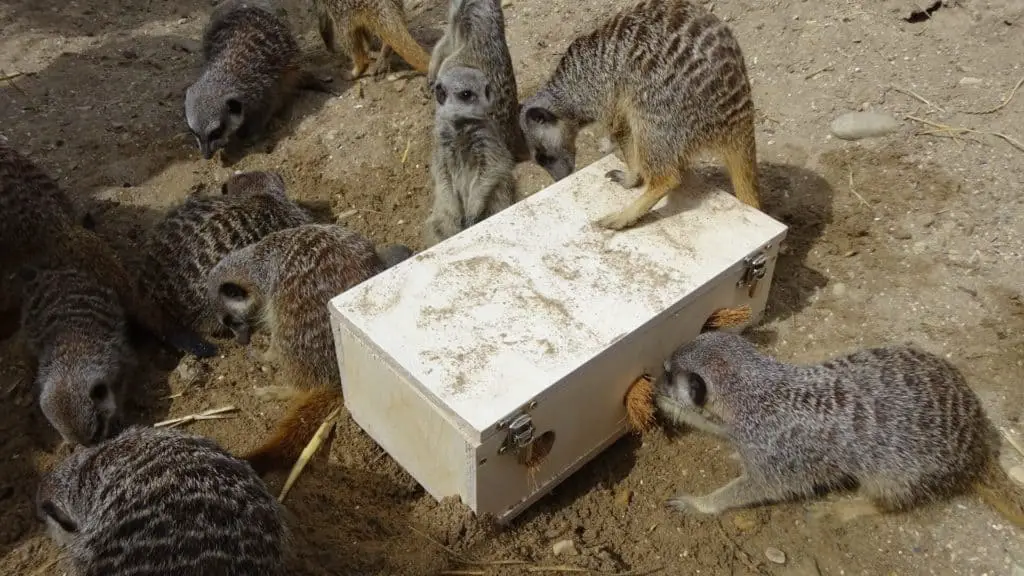In most animals, food is a powerful motivator of behaviour, so it will be no surprise that the manner and timing of feeding affect behaviour in captive animals. Appetitive behaviours are also strongly influenced by how food is presented. Food timing and presentation influence appetitive and consummatory behaviours, but also (food) aggression, abnormal behaviours and stereotypic behaviours. When thinking about food presentation and food enrichment, there is another interesting concept to take into account how to present food to animals in captivity: The contrafreeloading concept. But what does contrafreeloading means?
Contrafreeloading is the behaviour seen in most animals that when an animal is offered a choice between free food or identical food that requires effort, the animal prefers the food that requires effort (Glen Jensen, 1963). Within zoos it is applied as diet offered with the help of devices, substrate or locations to decrease or even completely remove free feeding to ultimately extending foraging time (Maple and Perdue, 2013)
What is contrafreeloading?
When an animal is provided with a choice between making an effort to obtain food or by eating it from a freely-available source, a curious thing happens. Animals tend to prefer to ‘work’ for their food and choose often the food that takes a certain effort. This phenomenon is called contrafreeloading. Although contrafreeloading (which means against free feeding) is not a new concept, it is not very well known and practised in captive animal care. This contrafreeloading behaviour is initially observed and described in 1963 by Glen Jensen, behavioural phycologist, but in 1925 Robert Yerkes already wrote that “The greatest possibility for improvement in our provision for captive primates lies in the invention and installation of apparatus which can be used for play or work.” In the research of Jensen (1963), he gave a group of rats the choice between food from a bowl and identical food that could be obtained by pressing a metal bar. His research resulted in that almost every single rat preferred the food that is obtained by pressing the bar. In similar research, this behaviour is seen by many other animals as well, such as but not limited to rats, chickens, starlings, gerbils, rhesus macaques, chimpanzees, giraffes, grizzly bears and maned wolves. This intriguing behaviour seems to directly contradict that an animal always chooses the path of least resistance. This ‘principle of least effort’ demonstrates that animals commonly try to minimize their energy expenditure while trying to maximize their rewards. So why do captive animals choose to ‘work’ for their food? Within behavioural ecology, much research is done to attempt to explain the contrafreeloading phenomenon. Current explanations are that 1) it fulfils a need to gain information about the environment (information primacy theory), 2) it allows the animal to express species-specific behaviours (gaining food out of a bowl does not cover natural appetitive behaviours) and 3) there is a behavioural emptiness because captive animals have not enough stimulation in their environment, so animals perform elaborate behaviours when given the opportunity. Certainly, there are to some extent limitations to this concept, as explained in this article ‘A limitation of the contrafreeloading phenomenon‘.
Why is contrafreeloading a valuable concept in zoos?
When translating this concept to a zoo setting, captive animals tend to choose to use an enrichment device to get food even when there is (identical) free food available. Many animals have an intense desire to forage for a longer time and perform more appetitive behaviours as their wild counterpart do. In the pursue to strive for high animal welfare in zoos, contrafreeloading should be integrated into the environmental enrichment program. Additionally, when animals spend more physical energy and performing more natural behaviours will prevent boredom, which can lead to developing abnormal and stereotypic behaviours.
How can you implement the contrafreeloading concept into enrichment?
We now know that contrafreeloading is demonstrated to work in many animals and can have a positive impact on animal welfare. When start applying contrafreeloading, it is helpful to first list the animals that profit most from contrafreeloading. What animals can least perform their natural appetitive (foraging) behaviours in their current environment? Start with these animals and use a small portion (5% – 25%) of their diet in such a way they have to work for. It will be visible that some animals directly prefer the food which takes effort when others will be slower at getting the non-free food. Once the animals are comfortable receiving their diet in a contrafreeloading-way, you can increase step-by-step the amount of non-free food and/or effort the animals need to make to get their food. It depends on the natural and life history of the animal how quickly it is comfortable getting his food in a contrafreeloading manner. It is important to keep in mind that the effort an animal has to make stimulates natural species-specific behaviours to make contrafreeloading work.

Further reading
- The S.P.I.D.E.R. Framework (article)
- Contrafreeloading and the value of control over visual stimuli in Japanese macaques (article)
- Contrafreeloading at the Phoenix Zoo (article)
Share this page!